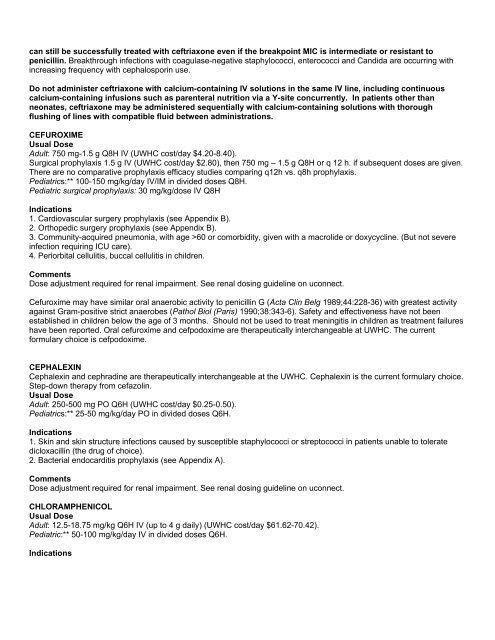Antimicrobial Use Guidelines (AMUG) version 21 - UW Health
Antimicrobial Use Guidelines (AMUG) version 21 - UW Health
Antimicrobial Use Guidelines (AMUG) version 21 - UW Health
Create successful ePaper yourself
Turn your PDF publications into a flip-book with our unique Google optimized e-Paper software.
can still be successfully treated with ceftriaxone even if the breakpoint MIC is intermediate or resistant topenicillin. Breakthrough infections with coagulase-negative staphylococci, enterococci and Candida are occurring withincreasing frequency with cephalosporin use.Do not administer ceftriaxone with calcium-containing IV solutions in the same IV line, including continuouscalcium-containing infusions such as parenteral nutrition via a Y-site concurrently. In patients other thanneonates, ceftriaxone may be administered sequentially with calcium-containing solutions with thoroughflushing of lines with compatible fluid between administrations.CEFUROXIMEUsual DoseAdult: 750 mg-1.5 g Q8H IV (<strong>UW</strong>HC cost/day $4.20-8.40).Surgical prophylaxis 1.5 g IV (<strong>UW</strong>HC cost/day $2.80), then 750 mg – 1.5 g Q8H or q 12 h. if subsequent doses are given.There are no comparative prophylaxis efficacy studies comparing q12h vs. q8h prophylaxis.Pediatrics:** 100-150 mg/kg/day IV/IM in divided doses Q8H.Pediatric surgical prophylaxis: 30 mg/kg/dose IV Q8HIndications1. Cardiovascular surgery prophylaxis (see Appendix B).2. Orthopedic surgery prophylaxis (see Appendix B).3. Community-acquired pneumonia, with age >60 or comorbidity, given with a macrolide or doxycycline. (But not severeinfection requiring ICU care).4. Periorbital cellulitis, buccal cellulitis in children.CommentsDose adjustment required for renal impairment. See renal dosing guideline on uconnect.Cefuroxime may have similar oral anaerobic activity to penicillin G (Acta Clin Belg 1989;44:228-36) with greatest activityagainst Gram-positive strict anaerobes (Pathol Biol (Paris) 1990;38:343-6). Safety and effectiveness have not beenestablished in children below the age of 3 months. Should not be used to treat meningitis in children as treatment failureshave been reported. Oral cefuroxime and cefpodoxime are therapeutically interchangeable at <strong>UW</strong>HC. The currentformulary choice is cefpodoxime.CEPHALEXINCephalexin and cephradine are therapeutically interchangeable at the <strong>UW</strong>HC. Cephalexin is the current formulary choice.Step-down therapy from cefazolin.Usual DoseAdult: 250-500 mg PO Q6H (<strong>UW</strong>HC cost/day $0.25-0.50).Pediatrics:** 25-50 mg/kg/day PO in divided doses Q6H.Indications1. Skin and skin structure infections caused by susceptible staphylococci or streptococci in patients unable to toleratedicloxacillin (the drug of choice).2. Bacterial endocarditis prophylaxis (see Appendix A).CommentsDose adjustment required for renal impairment. See renal dosing guideline on uconnect.CHLORAMPHENICOLUsual DoseAdult: 12.5-18.75 mg/kg Q6H IV (up to 4 g daily) (<strong>UW</strong>HC cost/day $61.62-70.42).Pediatric:** 50-100 mg/kg/day IV in divided doses Q6H.Indications
















